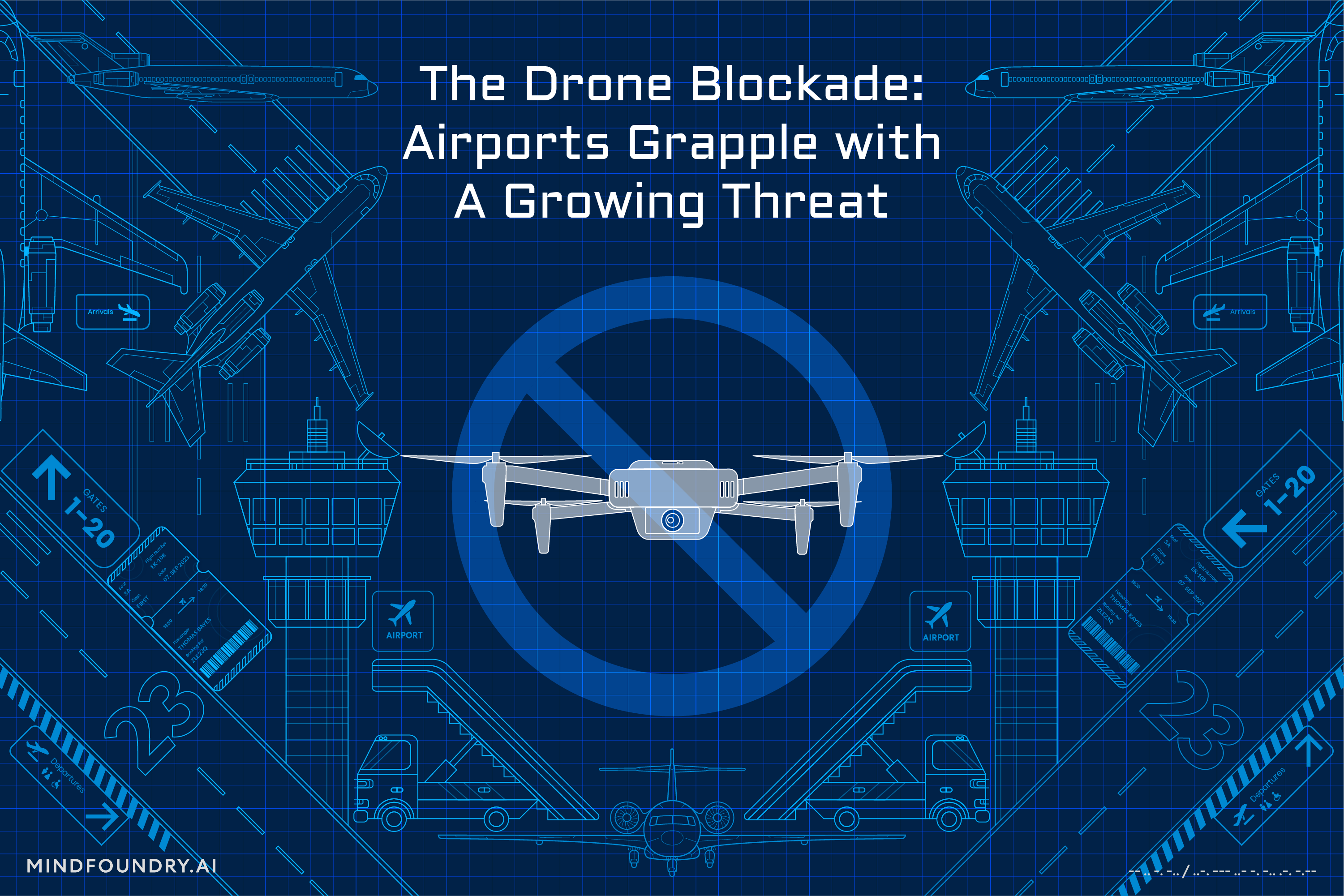AI-enabled Acoustic Intelligence for Anti-Submarine Warfare
From detecting hidden threats to defending critical underwater infrastructure, Anti-Submarine Warfare (ASW) is a cornerstone of national security. AI...
9 min read
Mind Foundry
:
Jun 17, 2025 10:59:20 AM

An uninvited buzz of drones in the air is forcing airports worldwide to rethink their approach to security. The implications are serious, impacting everything from airport operational continuity to passenger confidence.
In December 2018, Gatwick Airport, the UK’s second-busiest, was brought to a standstill by unauthorised drone activity, when reports of drones, sometimes two seen at once, forced an emergency shutdown of its runways. All told, there were 170 reported sightings, with 115 deemed credible, though no definitive photo or video evidence emerged. The shutdown stretched across 36 hours, with intermittent closures pushing the disruption to about 45 hours. This single airport drone disruption resulted in around 1,000 flights being cancelled, 110,000 passengers being stranded, and significant financial damage, with easyJet alone reporting a £15 million loss.
This wasn’t an isolated incident. From Dubai to Dublin, and more recently, with widespread disruptions in Russia, rogue drones have become a new and unpredictable threat to civilian airports. With the recent success of Ukraine’s Operation Spiderweb, or Israel's Operation Rising Lion, proving that low-cost drones can deliver a crippling blow deep inside any sovereign nation, those tasked with protecting critical national infrastructure like airports must be rethinking their approach to security.
One thing is clear: the old perimeter fence no longer cuts it. Airports are now forced to develop robust drone defence strategies against threats from above.
Once the preserve of militaries and deep-pocketed hobbyists, unmanned aircraft systems (UAS), or drones, now perform various tasks from delivering packages (at least in pilot schemes) to inspecting wind turbines. The market for unmanned aircraft (UA) and the systems that support them (ground control stations, command and control software, human operators) is soaring. Many analysts project the Unmanned Aircraft System (UAS) industry to be worth $123bn by 2030. However, this rapid growth brings serious challenges for aviation safety. The US Federal Aviation Administration (FAA) has now logged over 2,000 drone incursions near airports since 2021 – almost daily occurrences. And nearly two-thirds of near mid-air collisions at America’s 30 busiest airports feature drones.
The threat is not just from careless amateurs. The potential for drones to be used for reconnaissance, smuggling, or as improvised weapons has security services and international bodies like the International Civil Aviation Organisation (ICAO) sounding the alarm on airport security UAS challenges. “Technological responses to UAS,” ICAO states, are “paramount,” aligning with a clear need for effective counter-UAS solutions for aviation.
Enter Counter-UAS (C-UAS) technology, a field scrambling to keep pace.
Originally born out of military necessity, C-UAS for airports has evolved rapidly from rudimentary jammers to sophisticated, multi-layered defence shields. The question for airports is no longer whether to invest in airport anti-drone systems, but how to choose wisely in a complex and rapidly evolving market.

Detecting a small, erratically flying piece of plastic and electronics amidst a modern airport's metallic clutter and radio cacophony is no mean feat. No single sensor is a panacea for drone detection at airports. Instead, the watchword is “layers”; a fundamental necessity for a robust layered drone defence airport system. Each layer in a C-UAS airport architecture serves a distinct purpose, building upon the last to create a progressively clearer and more reliable picture of the airspace, thereby enabling a measured and appropriate response to preventing drone incursions at airports.
 “What is moving in our airspace? How far away is it? Do we need more information?”
“What is moving in our airspace? How far away is it? Do we need more information?”
The Outer “Detect” Layer is designed to offer broad coverage and act as an expansive early warning system for airport airspace protection. It must cast a wide net to pick up “rogue traffic” that could be located kilometres from the airport’s core infrastructure. The intelligence gleaned at this stage, whether from radar, RF, or acoustic whispers, serves as the crucial first tripwire. Precision is secondary to the probability of detection; the immediate goal is to sound an alert and narrow the search area for subsequent layers.
Typical Technologies for Airport Drone Detection:

“Is it a bird or a drone? What kind of drone? Where's it going?"
After the outer layer flags a potential threat, the middle layer locks on to refine the track and start classification. It distinguishes, for example, a drone from a bird; with deeper analysis, it can even tell the sound, RF or flight signature of a small fixed-wing drone from that of a multirotor. It is here that machine learning technologies for C-UAS become invaluable.
Typical Technologies for Drone Tracking and Classification:

“Is it carrying a visible payload? Is it behaving erratically? Is it on a direct path to a critical area? “
Building upon the characteristics initially flagged, the Inner Layer is dedicated to Positive Identification, Tracking, and Comprehensive Threat Assessment. This layer provides the definitive confirmation needed to escalate to a response, definitively dismissing false alarms or confirming UAS threats to airports.
Typical Technologies for Final Threat Confirmation:

“What do we do now?”
Once the Inner Layer has provided positive identification of an unauthorised drone and a comprehensive assessment of its characteristics and potential threat level, the C-UAS moves into the critical Response Layer. This is where all preceding efforts culminate in a decision and, if necessary and authorised, an action for airport drone mitigation.
The Pivotal Role of C2 Software and Situational Awareness:
At the heart of this layer is the Command and Control (C2) software. Having processed and fused data, the C2 system provides security operators with enhanced situational awareness. This includes:
Detection, however sophisticated, is but half the battle when considering how to protect airports from unauthorised drones. Once an unauthorised drone is confirmed, what then? The options for mitigation strategies for drones at airports are fraught with difficulty. Grounding all flights, as seen in the Gatwick drone incident, is financially ruinous, millions of dollars per hour for a major hub. Yet the alternative, a drone colliding with an aircraft, is unthinkable.
There are plenty of neutralisation technologies, each with its own drawbacks in the sensitive airport ecosystem:
Crucially, in most Western jurisdictions, the authority to deploy such countermeasures rests not with airport authorities but with federal law enforcement or security agencies. The legal implications of C-UAS at airports are significant, necessitating a carefully choreographed dance between detection on-site and response from officially sanctioned actors.

How can I get peace of mind? Will insurers help me cover the cost of business disruption?
Installing a full counter-drone shield is a significant investment. A layered system, potentially incorporating radar, RF detection, acoustic sensors, thermal cameras, and the C2 software that fuses them, can run into the millions for a large hub.
Upfront costs for civilian C-UAS hardware for municipal-level airspace have been estimated at around $5 million, with substantial ongoing annual subscription or maintenance costs that can be a considerable percentage of the initial outlay. On paper, that’s a hefty line item. In practice, it can be small next to the financial blast radius of a single drone-induced shutdown.
Gatwick’s 2018 incident starkly illustrates this. The 33-hour closure grounded over 1,000 flights, generating an estimated £50 million in airline claims and a direct loss to the airport of £1.4 million. This disruption cost is many times the potential price of a robust C-UAS stack. With direct aircraft operating costs for some major airlines around $100 per minute (approximately £75-£80, based on 2023 U.S. carrier data), even a brief precautionary runway stop due to a drone sighting can quickly accumulate significant costs across multiple affected flights. Preventing even one major disruption, or a costly false alarm that leads to an operational pause, can heavily offset the C-UAS investment.
Airports aren’t the only ones doing the maths; their insurers are, too. Aviation insurance programmes already bundle substantial third-party liability and business-interruption (BI) cover. Following high-profile disruptions like Gatwick, insurer scrutiny of airport drone risk mitigation strategies has understandably intensified, and leaders like Willis Tower Watson announced a “drone disruption aviation action plan” and published some supporting materials to help airports better understand C-UAS. The direction of travel is this: Underwriters are increasingly looking for evidence of effective "drone-intrusion controls" during renewals.
While the market is still evolving, best practices for airport C-UAS are emerging, often emphasising principles like multi-layered detection, capabilities for identifying drone characteristics (such as through Remote ID where feasible and legally implemented ), and well-rehearsed incident response plans. Airports demonstrating a comprehensive approach to managing drone risks, including effective C-UAS deployment, are likely to be viewed more favourably by underwriters.
Though specific, standardised premium credits across the market are not yet widely documented, a strong risk management posture is a key factor in insurance discussions. Any potential reduction in premiums would, of course, improve the C-UAS business case. For an airport with a multi-million-pound annual insurance bill, even a modest percentage consideration could represent a significant sum, helping to offset the C-UAS system's ongoing operational expenses.
This all points towards greater integration of C-UAS as a critical safety and security layer. Innovative insurance concepts, such as parametric "runway-closure" covers triggered by verified disruptions, are being discussed as potential future solutions for non-damage business interruption, though widespread piloting for drone-specific events is not yet confirmed.
Airports that invest proactively in effective C-UAS not only shrink their operational risk and public relations exposure but also strengthen their overall risk profile. While transforming the C-UAS line item into an immediate profit centre solely through insurance rebates might be optimistic, the primary ROI lies in preventing catastrophic losses and ensuring operational continuity.
The regulatory environment is, like the technology itself, in flux. ICAO, the FAA in America, and EASA in Europe are all working on frameworks, but harmonisation has been slow, and national laws add further layers of complexity. Airports must navigate this legal maze carefully, while keeping tabs on headlines coming out of Russia, Ukraine, Israel and Iran. The rules and regulations may change quickly.
Looking ahead, the cat-and-mouse game between drone capabilities and C-UAS countermeasures will continue. AI and machine learning will make detection smarter and responses more autonomous. Defences against drone swarms are being developed. The quest for safer, more precise non-kinetic effectors will intensify. And as legitimate drone traffic grows under new Unmanned Traffic Management systems, C-UAS will need to seamlessly distinguish the welcome from the unwelcome.
The challenge for airports is clear: to invest, adapt, and collaborate. The buzzing in the air is more than just a nuisance; it is a persistent feature of the modern aviation landscape. Ensuring it remains manageable requires vigilance, innovation, and recognition that in the 21st century, airport security extends well beyond the runway.
Interested in AI's potential to enhance Counter-UAS? Get in touch.

From detecting hidden threats to defending critical underwater infrastructure, Anti-Submarine Warfare (ASW) is a cornerstone of national security. AI...

The UK-USA Technology Prosperity Deal sees overseas organisations pledging £31 billion of investment into UK AI infrastructure. As AI investment...

Industrial AI is increasingly coming to the fore in physical industries, but achieving measurable real-world impact requires careful consideration...